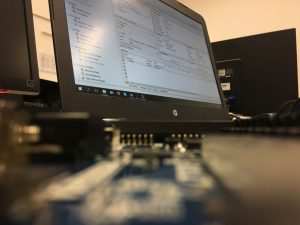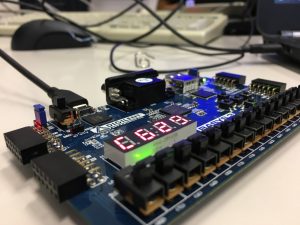Every two weeks we are asked to do, in a group of two students, a project with simple integrated circuits and/or VHDL.
Today we tested what is gonna be our last project of this kind, our last VHDL project developed in the subject of Digital Systems.
We were asked to develop, using vivado’s software, a sort of digital lock that would grant access if the right two digit code was inserted and would stay locked if the wrong code was inserted. If we put the wrong code more than a certain number of times we would have to wait 9 seconds (in our case, it would change depending on the group) before inserting another code. Even tho it sounds pretty simple, it isn’t, it gave us quite some work but, in the end, it was quite easier than the previous project we had to develop for this subject.
When we finished testing our program we were asked to take the program we had synthesised and, by implementing some changes, make it allow more tries before it started counting the 9 seconds previously mentioned.
The video below is the result of the implementation of our program in the board.
The code to open the digital lock was pressing twice in the left button (the first thing we do). After we enter the right code, the electronic board starts counting 5 seconds (the five seconds the lock will be “open” before it closes again and we have to, once more, insert the code).
The second time we press the buttons of the board we insert a wrong code. Nothing happens. We insert a wrong code a second time and the board starts counting, once again. This time, the electronic board will count nine seconds before it allows us to try a new code (this nine seconds are the ones i mentioned above the video in this post).


 Today we are gonna work with that same software again in our Digital Systems class. This time It was more complicated to prepare for the class and surely the class itself will be more complex. Nevertheless, I am still looking forward to experiment once again both with vivado and the electronic board where we implement the programs.
Today we are gonna work with that same software again in our Digital Systems class. This time It was more complicated to prepare for the class and surely the class itself will be more complex. Nevertheless, I am still looking forward to experiment once again both with vivado and the electronic board where we implement the programs.